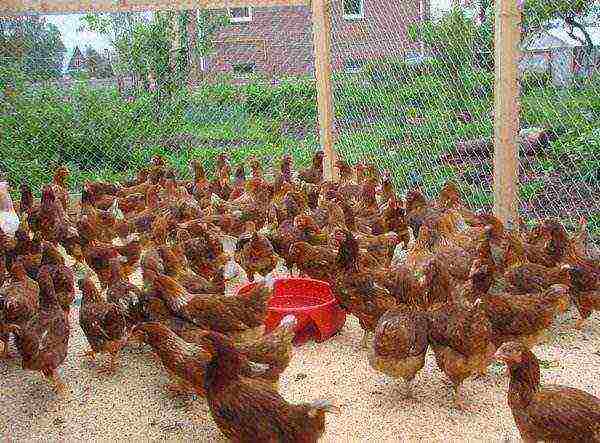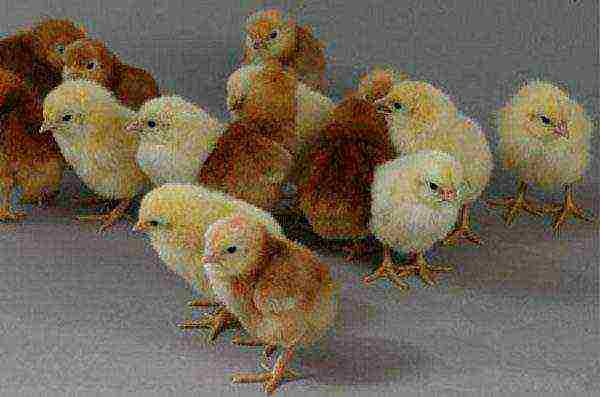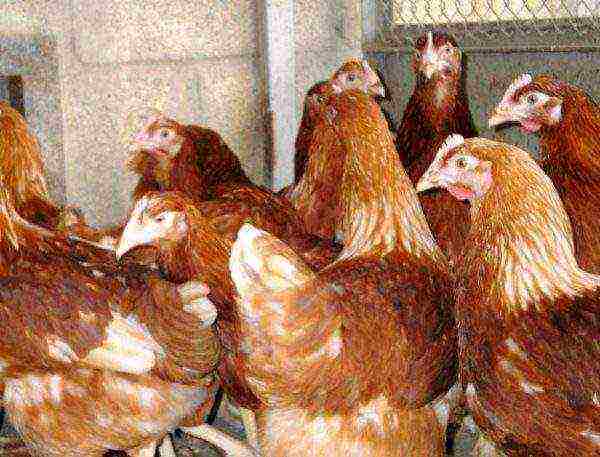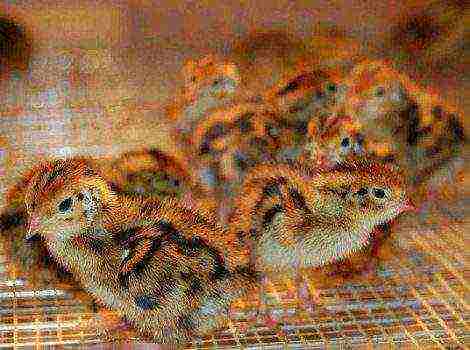Content [show]
Chickens rhodonite: description and characteristics
Chickens are the most popular type of poultry, which people have been keeping, breeding and breeding for thousands of years.
One of the most popular breeds of these domestic birds in Russia are Rhodonite chickens, bred relatively recently at the Sverdlovsky poultry factory in 2002-2008. In this article, we will consider the description and characteristics of chickens and hens of rhodonite layers.
Chickens of the rhodonite breed: characteristics and description
Rhode Island roosters and Loman Brown individuals on the maternal line were used to breed the Rhodonite 3 chicken breed, and therefore the variety obtained during the selection has the characteristics of both species.
The breed is distinguished by a medium-sized head, a yellow beak with a stripe in the middle and large bright red catkins and a leaf-shaped crest. The plumage, close to the body, has a light brown color with off-white blotches at the ends of the feathers in the area of the wings and tail.
Temperament and features of the content
Rhodonite is distinguished by its mobility, a high degree of activity, lack of aggressiveness, and adaptability.
Suitable for both industrial breeding and for breeding in a small household farm. One of the features of the breed is the unpretentiousness and adaptability of chickens, which allows them to be kept in a regular poultry house without warming the perimeter. This breed tolerates temperature fluctuations well, but to increase egg production in winter, the house should not be colder than 2 degrees below zero in the house.
An increased temperature over 28 degrees in the summer is also a factor that reduces egg production. At home, it is recommended to keep the house clean by periodically disinfecting the walls and ceiling by whitewashing the room. In a poultry farm, the density should not exceed 20 heads per area of 10 square meters.
Laying hen rhodonite: weight and egg production
There are five types of chicken separation:
- Egg breeds.
- Egg and meat.
- Broiler chickens.
- Decorative breeds.
- Fighting.
Rhodonite belongs to the egg type. Although many breeders grow this species, including for meat. Females can lay about 300 eggs per year, and the period of egg production begins at four months of age.

The eggs are relatively small, weighing about 60g. The eggshell is dark brown in color. The highest degree of egg production is observed in the first one and a half to two years. It is noteworthy that there is a special vaccine that can increase the reproductive performance of a middle-aged laying hen to initial levels for about 80 weeks.
The breed is distinguished by its low weight. Laying hens rhodonite reach a body weight of about 2 kg, roosters weigh about three on average. The skeleton of a bird is typical for laying hens, it is compact and lightweight. It is easy to distinguish chickens by sex already in the first day of life:
- The color of the down of the cockerels is yellow, the down of the hens is brown.
- For cockerels, dark circles around the eyes are characteristic, for hens, light circles.
Feeding
The bird is fed with combined feed and mash with the addition of fish or meat broth. In addition to compound feed, wheat or wheat groats can be given as dry food.Minerals and vitamins must be present in the Rhodonite diet, therefore, even in winter, it is recommended to use vegetables and dry herbs (nettles) for making mash.
Ground shells or eggshells, chalk or limestone are given as a source of calcium, since the lack of calcium in the diet leads to thinning of the eggshell in layers, or even its complete absence. To improve digestion, small stones or gravel are mixed in food for chickens. Chickens from the first to the eighth week of life are fed with combined feed PK-2, with the transition to PK-4 after the youngsters reach eight weeks of age.
In terms of feed costs, the Rhodonite cross is distinguished by a slightly higher degree compared to other common varieties of egg breeds. Thus, the average consumption of feed per head is about 42-43 kg for 18 months, while the consumption of feed for 10 eggs is approximately 1.36 kg or 2.10 kg of feed per kilogram of egg mass.
Breeding the breed
Due to the fact that the incubation instinct is extremely poorly developed in layers, the breeding of rhodonite chickens requires the presence of an incubator. Experts recommend purchasing chicks from large poultry farms.
Due to the high survival rate of young animals, this method is the most appropriate. But even when choosing a breeding method for Rhodonite through the purchase of chickens, the presence of at least one rooster in the flock is still necessary. Actually, the presence or absence of a rooster does not affect the level of egg production, however, according to the advice of experienced breeders, the presence of a male helps to maintain a kind of discipline in the poultry house.

Diseases and treatments
Like other birds, Rhodonite chickens can sometimes get sick. Bird health is an indispensable guarantee of high egg production. One of the most important conditions for this is keeping the house clean with timely disinfection and optimal feeding with the saturation of the body with the necessary complexes of vitamins, minerals and nutrients.
Chickens are less susceptible to diseases:
- jersey giant
- anniversary breed of chickens
- dominant
- Pavlovsk breed of chickens
- highsex brown
- loman brown
- adler silver
The organism of chicks is most susceptible to diseases. However, adults can also suffer from a number of diseases that can lead to a deterioration in the well-being of birds, as a consequence, to a decrease in egg production or even the death of a bird in especially severe cases. Here are some diseases that rhodonitis chickens may be susceptible to, including cross rhodonitis:
- Pullorosis. The disease affects young animals under two weeks of age. Symptoms are lowered wings, closed eyes, lack of appetite. Lethal outcome is inevitable.
- Pasteurellosis. Mostly chicks less than 3 months old are sick. The main symptoms of the disease are frothy mucous nasal discharge, pyrexia, yellow excrement. Treatment should be performed by a qualified veterinarian using antibiotics.
- Coccidiosis or damage to the gastric mucosa. As a rule, the main symptom of the disease is frequent loose stools with mucus and sometimes blood. For treatment, drugs with an anticoccidal effect are used. In the acute form of the disease, the death of young animals occurs after 3-5 days in the absence of treatment.
- Tuberculosis. The lungs are most often affected, but other organs can be affected. The bird stops rushing, suffers from a lack of appetite and a sharp decrease in weight, the comb becomes pale, the earrings become wrinkled. Upon confirmation of the diagnosis, the bird must be slaughtered.
- Mycoplasmosis. The disease manifests itself in a swollen area under the eyes, a sick bird may make strange unusual sounds. The disease affects egg production, causing it to decline.The prevention of the disease is the watering of the bird once a month with special drugs, such as Tilan or Tylosin.
- Pullorosis. Symptoms are thirst, increased breathing rate, upset stools, decreased appetite. Treatment occurs with antibiotics, in the absence of timely treatment, death often occurs.
- Bronchitis. Sick individuals practically stop laying, while the eggs have roughness on the shell. The virus enters the egg. Chicks hatched from such eggs are doomed from the beginning. Treatment is possible under the guidance of a qualified veterinarian.
- Salmonellosis. One of the most common diseases. Among other things, salmonellosis is dangerous for humans, as it can be transmitted through the eggs and meat of sick poultry. Furazolidone is used for treatment.
- Damage by parasites. Helminths, fleas, bugs often attack poultry. To eliminate helminths, anthelmintics are used. Ash helps from fleas, which should be placed in the poultry house, allowing the birds to take ash baths on their own as a preventive measure. Prevention of the appearance of ticks and bedbugs is to keep the poultry house clean with periodic disinfection of the room.
- Gastroenteritis. As a rule, it occurs against the background of eating poor-quality or not fresh food. Treatment, first of all, is to eliminate the cause that caused gastroenteritis. In some cases, it is advisable to carry out drug treatment with antibiotics.

Advantages and disadvantages
Summing up, we can separately say a few words about the advantages and disadvantages of the Rhodonite breed. The advantages of the breed include:
- High egg production.
- Ability to adapt to different temperature conditions while maintaining egg production.
- Fodder unpretentiousness.
- Good survival rate of young animals.
The disadvantages include only the lack of incubation instinct in Rhodonite females, which makes it impossible to breed chickens in a natural way with the help of a brood hen. However, the low mortality rate of chicks makes it possible to breed these chickens using an incubator or by purchasing day old chicks at a poultry farm.
Reviews
Andrei: Yes, I took this cross last year with an egg and day-old chicks at a poultry farm in the village of Novozavedennoe. In total, he raised about 300 females and 50 cockerels. The rooster is white with small splashes of red, the chicken is red and has white feathers in its tail and wings.
This cross is not bred. rather, the egg can be laid in an incubator. but chicks of a wide variety of colors are hatched. it is not clear where the chicken is. where is the cockerel. Hens were not among this cross. and I doubt that they would be hens. The testicles are carried practically every day. the egg is dark red, even somewhat burgundy.
In general, here is such an experience. Now I am transferring them to meat, although there is not much to eat, but there is no point in keeping them any longer. I still prefer Kuchinskaya Jubilee.Rhodonite is a champion in wear, over 300 eggs per year. It hatches very well in an incubator, the bird is beautiful.
Wearing depends on the mode of expression from the first day and timely vaccinations, the main thing is the light mode.The optimal weight for wearing is 1.8 - 2.3 kg. At the age of 14-15 months, the lenka begins, rejuvenation regimes are developed for a month, after which they rush for another 10-11 months almost like young people. Poultry Forum


